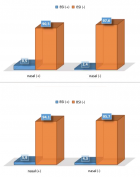Abstract
Mini Review
Chlorhexidine and oral cancer: A short review
Shrivardhan R Kalghatgi*, Mahesh R Khairnar and Tanushri Dalvi
Published: 18 February, 2020 | Volume 4 - Issue 1 | Pages: 001-002
Owing to the ever westernizing lifestyles in developing countries like India, the escalation of oral cancer patients are in need of urgent plan of action. With tobacco being the commonest cause for causation of oral cancer, Global Adult Tobacco Survey, 2016-17 revealed that almost 28% of whole population of India is consuming tobacco in either smoking or smokeless form. With these increasing numbers, the expected death toll to be expected to touch 1-2 million mark by the year 2035 [1].
Although, the current Onco-medicine fraternity excels in rendering care to oral cancer patients in the form of surgeries, chemotherapy and radiation-therapy. Often, these treatment modalities impart some unwanted adverse effects like, docetaxel (DCT) is known for its hepatotoxicity [2,3] whereas, one of the commonly used cisplatin (CIS) presents with nephrotoxicity, neurotoxicity, bone marrow suppression and vomiting [4,5]. Literature suggests of many non conventional medicaments being tested in past for their anti onco-genic effect, where few being effective and others being questionable ones. Chlorhexidine being one among them showing some how promising anti onco-genic activity with feeble amount of studies being conducted in past.
Chlorhexidine, one of the most commonly prescribed mouthrinse in the field of dentistry, with varying concentrations of 0.12% and 0.2% concentrations. Although, apart from being broad spectrum antibiotic, its capability to dismantle the protein – protein bond between anti – apoptotic Bcl-2 family protein Bcl-xL and its pro – apoptotic binding partners [6]. The current study was conducted on three cell lines of squamous cell carcinoma (SCC-4, SCC-9, SCC -15) and two pharynx carcinoma cell lines (FaDu and Detroit 562). The compounds induced apoptosis through mitochondria dependent apoptotic pathway in oral tumour cell lines. Another study conducted to assess the similar anti – oncogenic activites of chlorhexidine mouthrinse along with cranberry [7]. It was evident from results that, with increasing concentrations of chlorhexidine mouthrinse, there was increase in mean percent growth inhibition. The authors concluded saying, chlorhexidine has showed both anti cancerous as well as anti bacterial activity required to tackle common oral infections, part of common anti cancer therapy. Fernando Martínez-Pérez et al (2019) conducted study, where antitumor activity of Lipophilic Bismuth Nanoparticles (BisBAL NPs) and chlorhexidine on human squamous cell carcinoma was assessed using energy dispersive X – ray spectroscopy in conjunction with scanning electron microscopy (EDS-SEM). Study revealed, BisBAL NPs and chlorhexidine both showed cell growth inhibition on both cancer cell line (CAL-27) and human gingival fibroblasts (HGFs). Although, chlorhexidine showed non specific cytotoxicity for both tumoral and non tumoral control cells. The suggestive mechanism of action might be loss of cell membrane integrity [8].
Although Eliot MN (2013) conducted study, to assess the risk of head and neck squamous cell carcinoma secondary to use of alcohol containing and non alcoholic mouthwashes including chlorhexidine. The study was concluded with an assumption based on chlorhexidine mouthwash alters the oral flora [9], thus resulting in increasing risk exponentially through diverse change in oral bacteria and altered immune response with contribution towards genesis or promotion of cancer [10]. On the contrary, alcohol consumption and smoking are predisposing factors towards upper digestive tract cancer. The main causative factor being the first metabolite of alcohol, acetaldehyde. And much higher levels are derived from oral bacteria and thus, same can be altered in favour through usage of chlorhexidine mouthwash, to avoid excessive production of acetaldehyde intra orally.
In conclusion, chlorhexidine mouthwash has been into dental practice since long and the role it plays in either ways has to be assessed by a multi dimensional study with cell lines including that of control to derive better compared conclusions.
Read Full Article HTML DOI: 10.29328/journal.acst.1001012 Cite this Article Read Full Article PDF
References
- Bray F, Ren JS, Masuyer E, Ferlay J. Global estimates of cancer prevalence for 27 sites in the adult population in 2008. Int J Cancer. 2013; 132: 1133-1145. PubMed: https://www.ncbi.nlm.nih.gov/pubmed/22752881
- Yared JA, Tkaczuk KH. Update on taxane development: new analogs and new formulations. Drug Des Devel Ther. 2012; 6: 371–384. PubMed: https://www.ncbi.nlm.nih.gov/pubmed/23251087
- Wang Z, Liang X, Yu J, Zheng X, Zhu Y, et al. Non‐genetic risk factors and predicting efficacy for docetaxel–drug‐induced liver injury among metastatic breast cancer patients. J Gastroenterol Hepatol. 2012; 27: 1348–1352. PubMed: https://www.ncbi.nlm.nih.gov/pubmed/22432938
- Kilic U, Sahin K, Tuzcu M, Basak N, Orhan C, et al. Enhancement of cisplatin sensitivity in human cervical cancer: epigallocatechin-3-gal- late. Front Nutr. 2015; 1: 28. PubMed: https://www.ncbi.nlm.nih.gov/pubmed/25988128
- Kitagawa R, Katsumata N, Shibata T, Kamura T, Kasamatsu T, et al. Paclitaxel plus carboplatin versus paclitaxel plus cisplatin in metastatic or recurrent cervical cancer: the open-label randomized phase III trial JCOG0505. J Clin Oncol. 2015; 33: 2129–2135. PubMed: https://www.ncbi.nlm.nih.gov/pubmed/25732161
- Gräber M, Hell M, Gröst C, Friberg A, Sperl B, et al. Oral disinfectants inhibit protein-protein interactions mediated by the anti-apoptotic protein Bcl-xL and induce apoptosis in human oral tumor cells. Angew Chem Int Ed Engl. 2013; 52: 4487-4491. PubMed: https://www.ncbi.nlm.nih.gov/pubmed/23512547
- Khairnar MR, Wadgave U, Jadhav H, Naik R. Anticancer activity of chlorhexidine and cranberry extract: an in-vitro study. J Exp Ther Oncol. 2018; 12: 201-205. PubMed: https://www.ncbi.nlm.nih.gov/pubmed/29790310
- Martínez-Pérez F, García-Cuellar CM, Hernandez-Delgadillo R, Zaragoza-Magaña V, Sánchez-Pérez Y, et al. Comparative Study of Antitumor Activity between Lipophilic Bismuth Nanoparticles (BisBAL NPs) and Chlorhexidine on Human Squamous Cell Carcinoma. J Nanomaterials. 2019.
- Radford JR, Beighton D, Nugent Z, Jackson RJ. Effect of use of 0.05% cetylpyridinium chloride mouthwash on normal oral flora. J Dent. 1997; 25: 35–40. PubMed: https://www.ncbi.nlm.nih.gov/pubmed/9080738
- Eliot MN, Michaud DS, Langevin SM, McClean MD, Kelsey KT. Periodontal disease and mouthwash use are risk factors for head and neck squamous cell carcinoma. Cancer Causes Control. 2013; 24: 1315-1322. PubMed: https://www.ncbi.nlm.nih.gov/pubmed/23568534
Similar Articles
-
Theranostics: A Unique Concept to Nuclear MedicineLucio Mango*. Theranostics: A Unique Concept to Nuclear Medicine. . 2017 doi: 10.29328/journal.acst.1001001; 1: 001-004
-
Predictors of Candidemia infections and its associated risk of mortality among adult and pediatric cancer patients: A retrospective study in Lahore, Punjab, PakistanHafiz Muhammad Bilal*,Neelam Iqbal,Shazia Ayaz. Predictors of Candidemia infections and its associated risk of mortality among adult and pediatric cancer patients: A retrospective study in Lahore, Punjab, Pakistan. . 2018 doi: 10.29328/journal.acst.1001003; 2: 001-007
-
Endogenus toxicology: Modern physio-pathological aspects and relationship with new therapeutic strategies. An integrative discipline incorporating concepts from different research discipline like Biochemistry, Pharmacology and ToxicologyLuisetto M*,Naseer Almukhtar,Behzad Nili Ahmadabadi,Gamal Abdul Hamid,Ghulam Rasool Mashori,Kausar Rehman Khan,Farhan Ahmad Khan,Luca Cabianca. Endogenus toxicology: Modern physio-pathological aspects and relationship with new therapeutic strategies. An integrative discipline incorporating concepts from different research discipline like Biochemistry, Pharmacology and Toxicology . . 2019 doi: 10.29328/journal.acst.1001004; 3: 001-024
-
Insilico investigation of TNFSF10 signaling cascade in ovarian serous cystadenocarcinomaAsima Tayyeb*,Zafar Abbas Shah. Insilico investigation of TNFSF10 signaling cascade in ovarian serous cystadenocarcinoma. . 2019 doi: 10.29328/journal.acst.1001005; 3: 025-034
-
Fifth “dark” force completely change our understanding of the universeRobert Skopec*. Fifth “dark” force completely change our understanding of the universe. . 2019 doi: 10.29328/journal.acst.1001006; 3: 035-041
-
Risk factors of survival in breast cancerAkram Yazdani*. Risk factors of survival in breast cancer. . 2019 doi: 10.29328/journal.acst.1001007; 3: 042-044
-
Results of chemotherapy in the treatment of chronic lymphoid leukemia in Black Africa: Experience of Côte d’IvoirePacko Dieu-le-veut Saint-Cyr Sylvestre*,N’dhatz Comoe Emeraude,Kamara Ismael,Boidy Kouakou,Koffi Kouassi Gustave,Nanho Danho Clotaire,Koffi Kouassi Gustave. Results of chemotherapy in the treatment of chronic lymphoid leukemia in Black Africa: Experience of Côte d’Ivoire. . 2019 doi: 10.29328/journal.acst.1001008; 3: 045-048
-
Stercoral perforation: A rare case and reviewLava Krishna Kannappa*,Muhammad Sufian Khalid,May Hnin Lwin Ko,Mohsin Hussein,Jia Hui Choong,Ameer Omar Rawal-Pangarkar,Danaradja Armugam,Yahya Salama. Stercoral perforation: A rare case and review. . 2019 doi: 10.29328/journal.acst.1001009; 3: 049-051
-
Different optimization strategies for the optimal control of tumor growthAbd El Moniem NK*,Sweilam NH,Tharwat AA. Different optimization strategies for the optimal control of tumor growth. . 2019 doi: 10.29328/journal.acst.1001010; 3: 052-062
-
Risk factor of liver metastases in breast cancerAkram Yazdani*. Risk factor of liver metastases in breast cancer. . 2019 doi: 10.29328/journal.acst.1001011; 3: 063-065
Recently Viewed
-
Impact of Moringa oleifera Leaf Flour supplement on Weight Gain in Moderately Acutely Malnourished Children in BeninLaleye Flora Tinouade Founmilayo*, Fanou Fogny Nadia and Kayode Polycarpe. Impact of Moringa oleifera Leaf Flour supplement on Weight Gain in Moderately Acutely Malnourished Children in Benin. Arch Food Nutr Sci. 2023: doi: 10.29328/journal.afns.1001052; 7: 070-077
-
Drug Rehabilitation Centre-based Survey on Drug Dependence in District Shimla Himachal PradeshKanishka Saini,Palak Sharma,Bhawna Sharma*,Atul Kumar Dubey,Muskan Bhatnoo,Prajkta Thakur,Vanshika Chandel,Ritika Sinha. Drug Rehabilitation Centre-based Survey on Drug Dependence in District Shimla Himachal Pradesh. J Addict Ther Res. 2025: doi: 10.29328/journal.jatr.1001032; 9: 001-006
-
Feature Processing Methods: Recent Advances and Future TrendsShiying Bai,Lufeng Bai*. Feature Processing Methods: Recent Advances and Future Trends. J Clin Med Exp Images. 2025: doi: 10.29328/journal.jcmei.1001035; 9: 010-014
-
Relationship between Vitamin D Deficiency and Lipopolysaccharides Porphyromonas gingivalis Bacteria in Stunting ChildrenErwin Gunawan*,Ria Puspitawati. Relationship between Vitamin D Deficiency and Lipopolysaccharides Porphyromonas gingivalis Bacteria in Stunting Children. Ann Biomed Sci Eng. 2024: doi: 10.29328/journal.abse.1001033; 8: 059-065
-
Addiction to self-strangulation: a case-reportAurely Ameller*,Yann Le Strat,Marion Cadranel,Celine Portalier, Caroline Dubertret. Addiction to self-strangulation: a case-report . J Addict Ther Res. 2017: doi: 10.29328/journal.jatr.1001003; 1: 016-021
Most Viewed
-
Evaluation of Biostimulants Based on Recovered Protein Hydrolysates from Animal By-products as Plant Growth EnhancersH Pérez-Aguilar*, M Lacruz-Asaro, F Arán-Ais. Evaluation of Biostimulants Based on Recovered Protein Hydrolysates from Animal By-products as Plant Growth Enhancers. J Plant Sci Phytopathol. 2023 doi: 10.29328/journal.jpsp.1001104; 7: 042-047
-
Sinonasal Myxoma Extending into the Orbit in a 4-Year Old: A Case PresentationJulian A Purrinos*, Ramzi Younis. Sinonasal Myxoma Extending into the Orbit in a 4-Year Old: A Case Presentation. Arch Case Rep. 2024 doi: 10.29328/journal.acr.1001099; 8: 075-077
-
Feasibility study of magnetic sensing for detecting single-neuron action potentialsDenis Tonini,Kai Wu,Renata Saha,Jian-Ping Wang*. Feasibility study of magnetic sensing for detecting single-neuron action potentials. Ann Biomed Sci Eng. 2022 doi: 10.29328/journal.abse.1001018; 6: 019-029
-
Pediatric Dysgerminoma: Unveiling a Rare Ovarian TumorFaten Limaiem*, Khalil Saffar, Ahmed Halouani. Pediatric Dysgerminoma: Unveiling a Rare Ovarian Tumor. Arch Case Rep. 2024 doi: 10.29328/journal.acr.1001087; 8: 010-013
-
Physical activity can change the physiological and psychological circumstances during COVID-19 pandemic: A narrative reviewKhashayar Maroufi*. Physical activity can change the physiological and psychological circumstances during COVID-19 pandemic: A narrative review. J Sports Med Ther. 2021 doi: 10.29328/journal.jsmt.1001051; 6: 001-007

HSPI: We're glad you're here. Please click "create a new Query" if you are a new visitor to our website and need further information from us.
If you are already a member of our network and need to keep track of any developments regarding a question you have already submitted, click "take me to my Query."
















































































































































